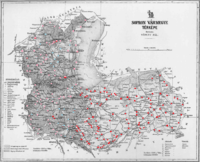Sopron County
| Sopron County Comitatus Soproniensis Sopron vármegye | |||||
| County of the Kingdom of Hungary | |||||
| |||||
|
Coat of arms | |||||
 | |||||
| Capital | Sopron 47°41′N 16°35′E / 47.683°N 16.583°ECoordinates: 47°41′N 16°35′E / 47.683°N 16.583°E | ||||
| History | |||||
| • | Established | 12th century | |||
| • | Treaty of Trianon | 4 June 1920 | |||
| Area | |||||
| • | 1910 | 3,256 km2 (1,257 sq mi) | |||
| Population | |||||
| • | 1910 | 283,500 | |||
| Density | 87.1 /km2 (225.5 /sq mi) | ||||
| Today part of | Austria, Hungary | ||||
Sopron (German: Ödenburg) was an administrative county (comitatus) of the Kingdom of Hungary in present-day eastern Austria and northwestern Hungary. The capital of the county was Sopron.
Geography
Sopron county shared borders with the Austrian land Lower Austria and the Hungarian counties Moson, Győr, Veszprém and Vas. The Lake Neusiedl (Hungarian: Fertő tó, German: Neusiedler See) lied in the county. Its area was 3,241 km² around 1910.
History
The Sopron comitatus arose as one of the first comitatus of the Kingdom of Hungary.
In 1920, by the Treaty of Trianon the western part of the county became part of the Austrian state of Burgenland, while the eastern part became a part of Hungary. In 1921, it was decided by referendum that the city of Sopron would join Hungary instead of Austria.
After World War II, Sopron county merged with Győr-Moson-Pozsony to form Győr-Sopron county. This county was renamed to Győr-Moson-Sopron county in the early 1990s. A small part of Sopron county went to Vas county.
Demographics
1900
In 1900, the county had a population of 279,796 people and was composed of the following linguistic communities:[1]
Total:
- Hungarian: 136,616 (48.8%)
- German: 109,369 (39.1%)
- Croatian: 31,317 (11.2%)
- Slovak: 505 (0.2%)
- Romanian: 22 (0.0%)
- Serbian: 12 (0.0%)
- Ruthenian: 4 (0.0%)
- Other or unknown: 1,951 (0.7%)
According to the census of 1900, the county was composed of the following religious communities:[2]
Total:
- Roman Catholic: 235,390 (84.1%)
- Lutheran: 33,924 (12.1%)
- Jewish: 9,736 (3,5)
- Calvinist: 641 (0.2%)
- Greek Catholic: 53 (0.0%)
- Greek Orthodox: 26 (0.0%)
- Unitarian: 15 (0.0%)
- Other or unknown: 11 (0.0%)
1910

In 1910, the county had a population of 283,510 people and was composed of the following linguistic communities:[3]
Total:
- Hungarian: 141,011 (49.7%)
- German: 109,160 (38.5%)
- Croatian: 31,004 (10.9%)
- Slovak: 397 (0.1%)
- Romanian: 33 (0.0%)
- Serbian: 15 (0.0%)
- Ruthenian: 4 (0.0%)
- Other or unknown: 1,886 (0.7%)
According to the census of 1910, the county was composed of the following religious communities:[4]
Total:
- Roman Catholic: 239,578 (84.5%)
- Lutheran: 34,820 (12.3%)
- Jewish: 8,192 (2,9)
- Calvinist: 743 (0.3%)
- Greek Catholic: 93 (0.0%)
- Greek Orthodox: 50 (0.0%)
- Unitarian: 27 (0.0%)
- Other or unknown: 7 (0.0%)
Subdivisions
In the early 20th century, the subdivisions of Sopron county were:
| Districts (járás) | |
|---|---|
| District | Capital |
| Csepreg | Csepreg |
| Csorna | Csorna |
| Felsőpulya | Felsőpulya, AT Oberpullendorf |
| Kapuvár | Kapuvár |
| Kismarton | Kismarton, AT Eisenstadt |
| Nagymarton | Nagymarton, AT Mattersburg |
| Sopron | Sopron |
| Urban counties (törvényhatósági jogú város) | |
| Sopron | |
| Urban districts (rendezett tanácsú város) | |
| Kismarton, AT Eisenstadt | |
| Ruszt, AT Rust | |
Eisenstadt, Mattersburg, Rust and Oberpullendorf are now in Austria.
References
- ↑ "KlimoTheca :: Könyvtár". Kt.lib.pte.hu. Retrieved 2012-06-25.
- ↑ "KlimoTheca :: Könyvtár". Kt.lib.pte.hu. Retrieved 2012-06-25.
- ↑ "KlimoTheca :: Könyvtár". Kt.lib.pte.hu. Retrieved 2012-06-25.
- ↑ "KlimoTheca :: Könyvtár". Kt.lib.pte.hu. Retrieved 2012-06-25.

